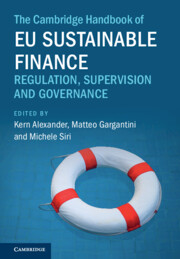Book contents
- The Cambridge Handbook of EU Sustainable Finance
- The Cambridge Handbook of EU Sustainable Finance
- Copyright page
- Contents
- Figures
- Tables
- Contributors
- Preface
- Acknowledgements
- Part I Introduction
- Part II Ethics and Sustainability in Corporate Law, Corporate Governance and Conduct
- Part III Integrating Sustainability in Financial Markets Regulation
- 10 Sustainability-Related Materiality in the SFDR
- 11 Information Intermediaries and Sustainability
- 12 On the Sustainability of the MiFID II and IDD Investor Protection Frameworks
- 13 The EU Taxonomy Regulation and the Prevention of Greenwashing
- 14 Integrating Sustainable Finance into the Prospectus Regulation
- 15 Disclosure Regulation and Sustainability
- 16 Institutional Investors as the Primary Users of Sustainability Reporting
- 17 The Role of Non-Financial Disclosure and Liability in Sustainable Finance
- Part IV Ensuring Financial Stability and Sustainability
- Part V Financial Innovation and Sustainability
- Index
- References
11 - Information Intermediaries and Sustainability
The Case of ESG Ratings and Benchmarks
from Part III - Integrating Sustainability in Financial Markets Regulation
Published online by Cambridge University Press: 30 January 2025
- The Cambridge Handbook of EU Sustainable Finance
- The Cambridge Handbook of EU Sustainable Finance
- Copyright page
- Contents
- Figures
- Tables
- Contributors
- Preface
- Acknowledgements
- Part I Introduction
- Part II Ethics and Sustainability in Corporate Law, Corporate Governance and Conduct
- Part III Integrating Sustainability in Financial Markets Regulation
- 10 Sustainability-Related Materiality in the SFDR
- 11 Information Intermediaries and Sustainability
- 12 On the Sustainability of the MiFID II and IDD Investor Protection Frameworks
- 13 The EU Taxonomy Regulation and the Prevention of Greenwashing
- 14 Integrating Sustainable Finance into the Prospectus Regulation
- 15 Disclosure Regulation and Sustainability
- 16 Institutional Investors as the Primary Users of Sustainability Reporting
- 17 The Role of Non-Financial Disclosure and Liability in Sustainable Finance
- Part IV Ensuring Financial Stability and Sustainability
- Part V Financial Innovation and Sustainability
- Index
- References
Summary
The relatively new world of ESG indicators displays many similarities with the original markets for ratings and benchmarks, but it also has some distinguishing features. This chapter explores to what extent the regulatory strategies that were developed in ‘traditional’ financial law to support confidence in ratings and benchmarks can be exported to the ‘new’ world of ESG finance, and concludes that policymakers should be cautions when transposing rules. This is especially the case with ESG ratings. In this area, credit ratings are the immediate reference for ESG rating regulation also, because of the common label of ‘rating’, which is rather misleading, and of the anchoring effect this entails. First, the assessments underlying ESG ratings are often more subjective than those supporting traditional indicators, due to their multivariate nature. Second, the risk of regulatory failures connected to the authorisation and registration labels also seems higher in the ‘new’ world of sustainability. The chapter analyses the new ESG Ratings Regulation and the Benchamkr Regulation against this backdrop, and highlights the suboptimality of some policy choices.
Keywords
- Type
- Chapter
- Information
- The Cambridge Handbook of EU Sustainable FinanceRegulation, Supervision and Governance, pp. 280 - 316Publisher: Cambridge University PressPrint publication year: 2025

